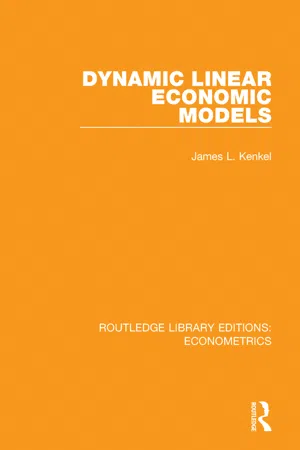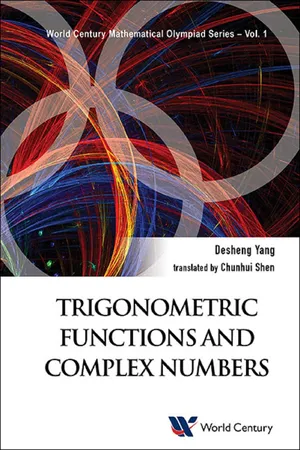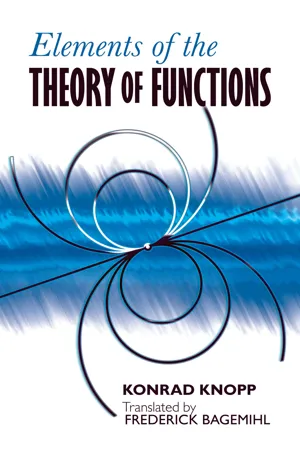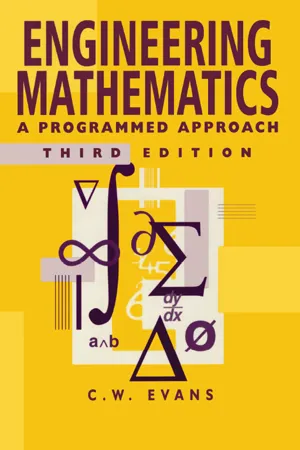Mathematics
Modulus and Phase
In mathematics, the modulus and phase of a complex number are key components of its polar form. The modulus represents the distance of the complex number from the origin in the complex plane, while the phase indicates the angle formed between the positive real axis and the line connecting the complex number to the origin. These concepts are fundamental in understanding complex numbers and their geometric interpretation.
Written by Perlego with AI-assistance
Related key terms
Related key terms
1 of 4
Related key terms
1 of 3
6 Key excerpts on "Modulus and Phase"
- eBook - ePub
- James L. Kenkel(Author)
- 2018(Publication Date)
- Routledge(Publisher)
The modulus of a complex number P represents the distance (always non-negative) of the point P from the origin, just as the absolute value of a real number x represents the distance (non-negative) of the point x from the origin. We define division of the complex numbers (a, b) and (c, d) as (a, b) (c, d) = ac + bd c 2 + d 2, bc − ad c 2 + d 2. Using the other notation we. obtain a + bi c + di = a + bi c + di ⋅ c − di c − di = ac + bd + (bc − ad) i c 2 + d 2 = ac + bd c 2 + d 2 + bc + ad c 2 + d 2 i In many problems involving complex numbers we make use of the fact that (x+yi) (x-yi)=x 2 + y 2. Thus any complex number z multiplied by its complex conjugate z ¯ yields a real number. It is this property which makes the concept of complex conjugates a useful one. Example : Let z 1 = (2, 3) = 2 + 3i z 2 = (4, −2) = 4 − 2i Then the following results follow from the definitions We define multiplication of the complex number (x, y) by the real number c as c(x, y)=(cx, cy) or as c(x + yi) = cx + cyi. Notice that we get the same result if we treat the real number c as the complex number (c, 0). We obtain (c, 0) ⋅ (x, y) = (cx, cy) or (c + 0i) (x + yi) = cx + cyi so we see that treating the real number c as the complex number (c, 0) causes no problems. Now we shall consider another way of expressing a complex number. First, it is necessary to introduce some elementary ideas from trigonometry. The trigonometric functions are best defined in terms of the unit circle. The circle in Figure 5 has radius of one and center at the origin. Figure 5 All angles are measured initially in terms of degrees. The angles we shall be interested in are those which have a vertex at the origin. As the point C moves around the circle, the central angle θ is generated. Angle θ represents the angle between the lines OA and OC. Angles measured in the counter-clockwise direction are positive, while angles measured in the clockwise direction are negative - eBook - ePub
- Desheng Yang, Chunhui Shen;;;(Authors)
- 2016(Publication Date)
- WCPC(Publisher)
PART II
Complex Number
Passage contains an image
Chapter 7
Concept of Complex Number
Imaginary Unit, Complex Number, Modulus of Complex Number1.i2 = −1, the number i is called imaginary unit; suppose a, b ∈ R, any number of the form z = a + bi is called a complex number, a is the real part of z, and b is the imaginary part of z. We write a = Re z, b = Im z. To complex number z = a + bi, when b = 0, z is the real number; when b = 0, z is called an imaginary number; when a = 0 and b = 0, z is called a purely imaginary number. A collection of all complex numbers is called complex set, and we write it C.2.In the plane rectangular coordinate system, Z(a, b) expresses complex number a + bi. The distance from Z to origin is called modulus of complex number. The modulus of z = a + bi (a, b ∈ R) is written |z| or |a + bi|, and3.To learn the concept of complex number, pay attention to the following:(1) When we write the algebraic form of complex number a + bi, do not leave out a, b ∈ R. If not, a, b do not necessarily express the real and imaginary parts of the complex number, and in this case, the definition of equality of complex numbers and formula for modulus of complex numbers cannot be used. Do not think that a complex number must be an imaginary number, and do not even think a complex number is certainly not a real number. Should master the following relations: complex number a + bi (a, b ∈ R),(2) If two complex numbers are not real numbers, the size of them cannot be compared. That is two imaginary numbers cannot be compared the size and a real number and an imaginary number cannot be compare the size. Only two real numbers can be compared the size.(3) - eBook - ePub
- Konrad Knopp, Bagemihl, Frederick, Bagemihl, Frederick(Authors)
- 2016(Publication Date)
- Dover Publications(Publisher)
Each of the axes divides the plane into two half-planes, which are called, in virtue of their position, upper and lower, left and right, half-planes, respectively. The origin of coordinates, i.e., the point or the number pair (0, 0), or the null vector, is called, briefly, the point 0 of the plane, or simply the origin. Those complex numbers whose representative points lie on the axis of reals, and whose vectors, consequently, are parallel to it, are called, for brevity, real ; all the remaining ones, not real or non-real ; those for which the representative points lie on the axis of imaginaries (or whose vectors are parallel to it) are called pure imaginary. 14 The first of the two polar coordinates (introduced in accordance with §3) of the point a, or, in other words, the length of the vector a, which we shall denote by ρ, is called the modulus or the absolute value of the complex number a ; the second, φ, which gives the direction of the vector a, is called its amplitude ; 15 in symbols: The amplitude of a complex number is thus infinitely multiple-valued, just as the second polar coordinate. All its values, however, differ only by integral multiples of 2π: they are “congruent to one another mod 2π.” That value of the amplitude which satisfies the condition – π < φ ≦ + π is called the principal value of the amplitude of a. Two complex numbers are said to have the same amplitude if the two amplitudes are congruent mod 2π, or, in other words, if their principal values coincide. The absolute value of a complex number is a real, non-negative number; it is equal to zero only if the complex number in question is (0, 0), i.e., zero. For this number, the amplitude is regarded as undefined or indeterminate. The connection between the Cartesian coordinates (α, α ′) and the polar coordinates ρ, φ of a complex number a different from (0, 0) is given, according to §3, by the formulas 16 (see Fig - eBook - ePub
Engineering Mathematics
A Programmed Approach, 3th Edition
- C W. Evans(Author)
- 2019(Publication Date)
- Routledge(Publisher)
x) when θ ∈ (−π/2, π/2).It follows that any non-zero complex number can be represented uniquely by the modulus r and the argument θ. The notation r∠θ is often used to denote these essential ingredients. When a complex number is expressed in polar form where θ is the argument of the complex number, so that −π < θ ⩽ π, it is said to be in modulus-argument form.□ Express the complex number 1 − 2i in the form r∠θ.We begin by representing the complex number by a point on the Argand diagram (Fig. 10.3 ): 1 − 2i → (1, −2). We calculate the modulus straight away using Pythagoras’s theorem:r 2=a 2+b 2=1 2+= 5(2− 2)and therefore the modulus is √5. The argument can be read from the diagram using a little trigonometry. The acute angle α is given by tan−1 2 ≃ 63°26′ or 63.44°, so that r = √5 and θ = –tan–1 2.■Fig. 10.3 Cartesian representation of 1 − 2i.Note that we can express the argument in degrees if we wish, but we must indicate clearly that we have done so. In many ways it is best to get used to the natural measure of angle, the so-called radian (π radians = 180 degrees). For instance, in the series expansion for the circular functioncos x = 1 −1 2x 2+ …x is the natural measure of angle, and it would be incorrect to attempt to use degrees.COMPLEX CONJUGATEIf z = a + ib, we denote the modulus of z by |z| and the argument of z by arg z.Another useful concept, which we have already used implicitly, is known as the complex conjugate of z and is denoted byz ¯. If z = a + ib then we definez ¯= a − ib. It follows thatwhich is a real number.zz ¯=(a + i b)(=a − i b)a 2−(2i b)=a 2+b 2=| z |2We can use this to reduce any rational expression involving complex numbers to the form a + ib, where a and b - eBook - ePub
- Huw Fox, William Bolton(Authors)
- 2002(Publication Date)
- Butterworth-Heinemann(Publisher)
Figure 2.22 shows how we represent the complex numbers 3 + j2 and −2 − j3 on such a diagram. The line joining the number to the origin is taken as the graphical representation of the complex number.Figure 2.22 Argand diagramModulus and argument
If the complex number z = a + jb is represented on an Argand diagram by the line OP, as in Figure 2.23 , then the length r of the line OP is called the modulus of the complex number and its inclination θ to the real number axis is termed the argument of the complex number. The length of the line is denoted by |z | or modulus z and the argument by θ or arg z .Figure 2.23 Modulus and argumentKey pointUsing Pythagoras’ theorem:We can specify a complex number on an Argand diagram in terms of its Cartesian coordinates as z = a + jb , or its polar coordinates z = r ∠θ.[13]and, since tan θ = b /a :[14]Since a = r cos θ and b = r sin θ, we can write a complex number z as:[15]Thus we can specify a complex number by either stating its location on an Argand diagram in terms of its Cartesian coordinates a and b or by specifying the modulus, |z | = r , and the argument θ. These are termed its polar coordinates . The specification in polar coordinates can be written as:[16]Example Determine the modulus and argument of the complex number 2 + j2. In polar form the complex number could be written as 2.8 ∠45°.Example Write the complex number −2 + j2 in polar form.If we sketch an Argand diagram (Figure 2.24 - eBook - ePub
- Paul Hill(Author)
- 2018(Publication Date)
- CRC Press(Publisher)
Figure 2.4 ).This spatial representation is especially useful in understanding the basic operations on complex numbers. Specifically, the addition and multiplication of complex numbers follow the laws of vector addition (Figure 2.5 ) and rotation/expansion explained below (Figure 2.6 ).Within MATLAB , all single numbers and the elements of vectors or matrices can be either real or complex. A simple example of a variable A being initialised as a complex number is (as illustrated in Figure 2.4 )FIGURE 2.4: Example of an Argand diagram with x = 2.2 and y = 2.5: A = 2.2 + 2.5i.The length of a complex number “vector” is known as its magnitude or absolute value (and more rarely its modulus). It is defined mathematically as |A| and is calculated from Pythagoras’ theorem as| A | =wherex 2+y 2A = x + i y. In MATLAB , complex magnitude is obtained using the abs function:The angle of a complex number (the angle measured anticlockwise from the real axis to the complex vector) is known as its argument (or just angle) and is defined as∠ A = t awheren( y / x )− 1A = x + i y.3 In MATLAB , a complex value’s angle/argument is obtained using the angle function, e.g.,The answer to angle is always given in radians. This is converted to degrees in the above listings using the MATLAB function radtodeg
Index pages curate the most relevant extracts from our library of academic textbooks. They’ve been created using an in-house natural language model (NLM), each adding context and meaning to key research topics.
Explore more topic indexes
Explore more topic indexes
1 of 6
Explore more topic indexes
1 of 4





